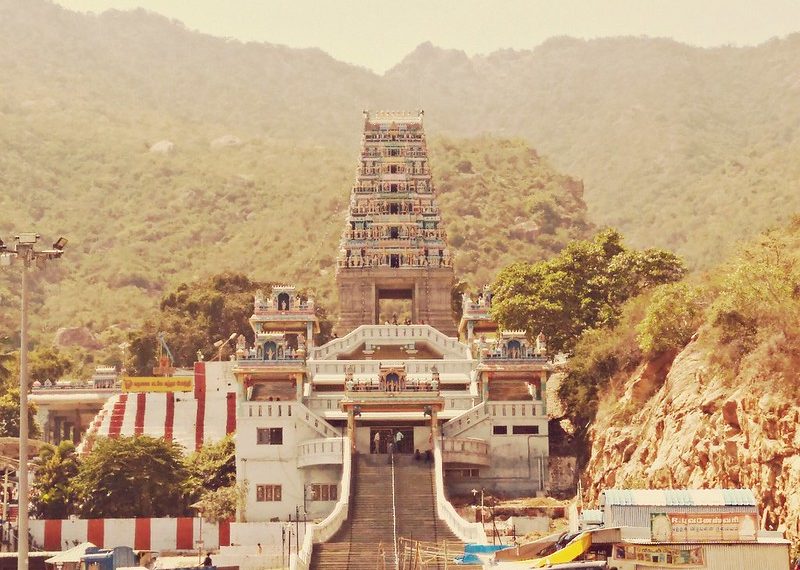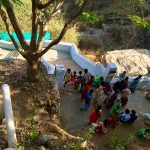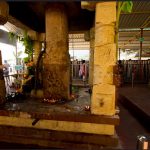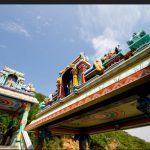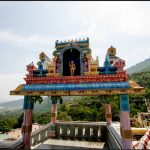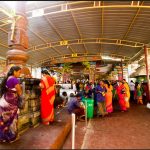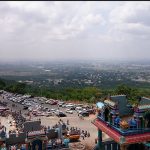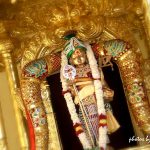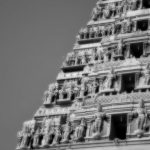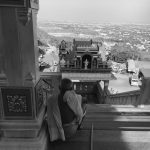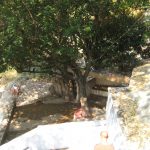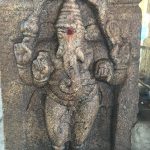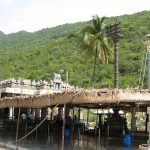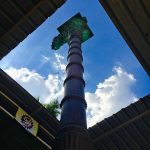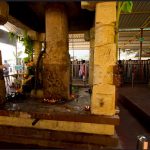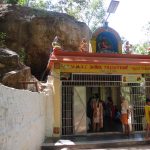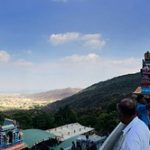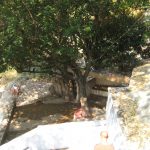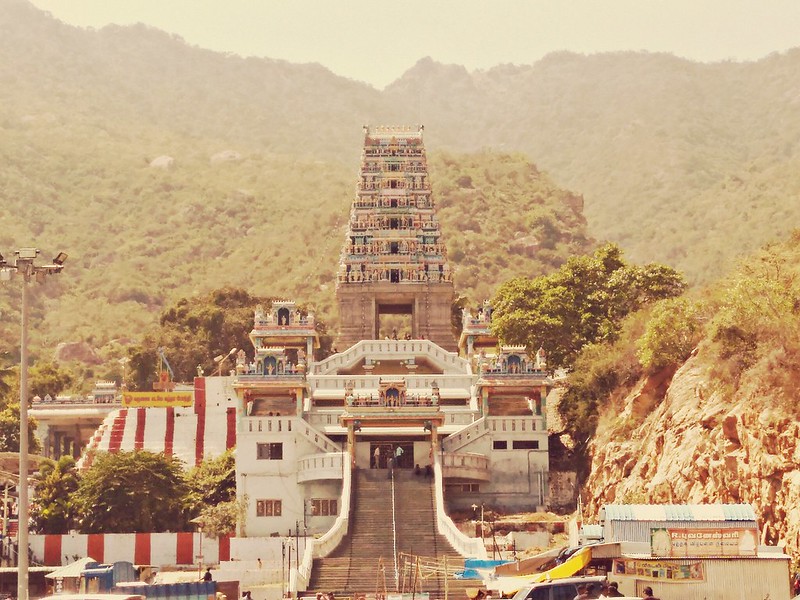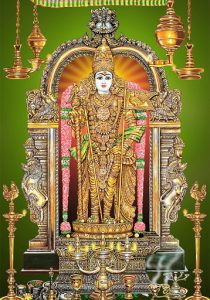
Main Deity – Marudamalai Temple
Nestled in the UNESCO World Heritage Site of the Western Ghats, the Marudhamalai Sri Subrahmanya Swamy Temple lies on the outskirts of the city of Coimbatore. This 1,200-year-old Temple on a small hillock at a height of about 500 feet in a plateau on the Western Ghats, amidst lush vegetation and salubrious climate. The Temple can be accessed via a long flight of steps, and from the top you can experience the views of the surrounding landscape. The hill is also home to a multitude of medicinal herbs that are used in the preparation of various Ayurvedic medicines. Two festivals that are celebrated here with much fanfare are the Thai Poosam, in January and February and Thiru Karthigai, in November or December. (Thai is a Tamil month from Jan- Feb; Poosam is Pushya Nakshatra in Tamil) (Tamil month of Karthigai comes in Nov – Dec)
Other attractions nearby include Thaan Thondri Vinaayakar, a Temple for Pillayar (Shri Ganesha) that lies at the foothills and a cave temple, called Paambaatti Sitthar Kugai, which is dedicated to a Siddar, a sage believed to have supernatural powers, who lived in the area.
About Marudhamalai Murugan Temple
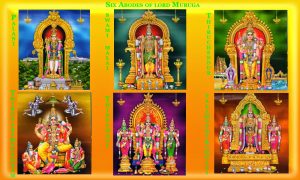
Arupadai Murugan
Marudhamalai Hills, dedicated to Bhagwan Muruga (Dandāyudhapāni) is classified under Kunruthoradal, one of the six main abodes of the God (Arupadai Veedu in Tamil). Set against the backdrop of hazy blue hills dotted with shrubs and bushes of varied hues, the sacred shrine verily reflects the picture of Lord Muruga, magnificently mounted on his vahana peacock, flaunting and swaying its feathers and plume in full bloom. Bhagwan Murugan is glorified as the God of mountain and mountainous regions in THIRU MUGURUGATRUPADI, a noted work of the Tamil Literature of the Sangam Age. The word Muruga is a comprehensive term, connoting several meanings such as sweetness, youthfulness, beauty, divinity and honey and therefore it is but natural for the God to have His abode amidst scenic beauty among hills and mountains. Marudhamalai Hills, dedicated to God Murugan (Maruthachalamoorthy) is classified under KUNRUTHORADAL, one of the six main abodes of the God, the others being THIRUVAVINANKUDI (PALANI), THIRUPARANGUNRAM, (NEAR MADURAI), THIRUCHEERALAVAI (Thiruchendur), THIRUVERAGAM (Swamimalai) and PAZHAMUDHIRSOLAI (Azhagarkoil near Madurai), THIRUTHANI.
Set against the backdrop of hazy blue hills dotted with shrubs and bushes of varied hues, the sacred shrine verily reflects the picture of God Muruga, magnificently mounted on his vahana peacock, flaunting and swaying its feathers and plume in full bloom.
Now we learn about few Sattology events happened in this place

Panorama view – Marudamalai Temple
The Sattology of the Temple can be traced in such ancient works as Sage Kachyapar’s PERUR PURANAM. The origin of the Temple is rooted in legendary antiquity and dates back to the age of Surapadama, the demon destroyed by Bhagwan Subrahmanya referred to in SKANDAPURANAM. The inscriptions found in Thirumuruganathaswami Temple, Thirumurganpoondi places the origin of the Temple in the 12th century A.D.
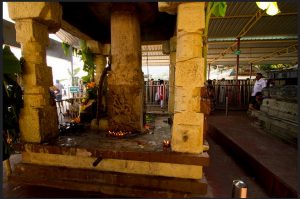
In front of main deity – Marudamalai Temple
Kongu Nadu was divided into 24 regions in the early days. It is learnt that one such Arai Nadu in the west has its boundary in the Marudhamalai Hills. Perur Puranam and the inscriptions at Tiru Murugan Poondi speak of Marudhamalai as the very manifestations of God Muruga Himself and the Marudham tree (Terminalia arjuna in English) as the symbolic representation of his spear (vel), Marudham Tree is a Sthal Vriksh here. Marudhamalai is celebrated by Sage Arunagirinathar in his celestial songs. According to Perur puranam (Pauranika), Soorapadama, the scourge of the Gods aided by his mighty brothers, Singamukha and Tharaka arrayed against them and struck terror in their already agitated minds by his sudden and surprising charges and depredations. Unable to bear the agony and anguish, the Gods approached Bhagwan Shiva and sought His succor. Bhagwan Shiva comforted the Gods that God Muruga would come to their rescue, root out and destroy Surapadama and his retinue en-masse. The Gods should hasten to the Marudhamalai Hills and await the advent of Bhagwan Muruga, their Saviour! Perur puranam also alludes to a king called Kusathvajan, who, it is said, was blessed with a male issue, only after worshiping Marudhamalai Muruga. The Divine Cow Kamadhenu is reported to have grazed in the pastures of the hills of Marudhamalai. Perurpuranam lists the three neighboring hills, vellingiri, Nili and Marudhamalai as the very manifestations of Bhagwan Shiva, Parvathi and Subrahmanya respectively and the three hills taken together as the very symbol of Somaskanda.
Perur puranam lists the three neighboring hills, Vellingiri, Nili and Marudhamalai as the very manifestations of Lord Siva, Parvati and Subramanya respectively and the three hills taken together as the very symbol of Somaskanda. A siddha, overcome by excessive tiredness and thirst, sought shelter under the shade of a marudham tree and prayed for the mercy of Bhagwan Muruga for a shower of water, which sprang at once, as though by a miracle from the tree.
As water gushed out from the roots of the marudham tree, the siddha jumped in joy, glorifying Muruga as the Lord of Marudham and jalam (water). With the passage of time, Marudhajalapati became Marudhachalapati.
Details of Deities in the Temple
Thanthonri Vinayagar :
As we approach the foothills, at a little distance from it, the deity Ganesha greet us. Offering our prayers to Śrī Vigneshwara, the remover of obstacles, we begin our ascent to the hills. It is significant to note that the deity is not a chiseled one but it is of a spontaneous origin (Swayambu). The ‘Thanthonri Vināyagar’ (self-born) is extolled in the ‘Marudhamalai Thanthonri Pathigam’ of Perur Puranam. Tamil scholars are keenly devoted to the Lord.
After worshipping Thanthonri Vināyagar, we ascend what is known as ‘Pathinettam Padi’, which has exactly a flight of eighteen steps, reminding us of Lord Ayyappa. Such if those as could not undertake the strenuous trek to the Sabari Hills offer worships here and fulfil their vows.
The flight of steps from the foothill to the top causes hardly any strain; rather the climb is light and exhilarating as one goes up the neatly carved steps, gazing round the luxuriant growth of vegetation and breathing the refreshing cool breeze wafted along the herbs of the hills.
Primal Shrine
The presiding deity, it is said, is a later installation, the original deity being that of Bhagwan Subrhamanya with His two consorts, Valli and Deyvannai, enshrined nearby to the south in the outer Prakara. They are the very deities referred to in the Perur Puranam. It is here the Gods persecuted by Surapadama approached Bhagwan Subrahmanya and implored Him to destroy the demon. The deities are all of spontaneous origin (swayambhu).
The Main Shrine
The shrine is not a big one. The sanctum sanctorum and the Ardha Mandapam are comparatively small. The front mandapam is wide enough to accommodate a fairly large number of devotees. Sivalingam flanks the presiding deity on the left and Ambigai on the right in the outer Prakara.
Uchipillayar Kovil
Two kilometers north of the main shrine is situated ‘Uchipilliayar Kovil’ gracing the devotees. The idol has been installed recently. On every ‘Chathurthi’ the deity is bedewed, anointed and adorned and devotees throng the temple in great numbers to worship on that day.
Right from foot hills to the temple on top we find elegantly built mandapams erected for devotees to take rest. These are a boon to the sevarthees who frequent the temple.
Other Shrines in nearby areas
To the right of the main shrine inside the prakara we find Sri. Patteeswarar shrine (the main deity of Perur). To the left is located Sri. Maragathambigai shrine (the main goddess of Perur). The main shrine of Shri Muruga is a unique Somaskanda Moorthy as the Lord is enshrined between
Just in front of Maragathambigai, we have the Navagraha shrine. Another unique feature of the Temple is the Perumal shrine towards the left of Alangara Mandapam. The Sapta Kanimar shrine is located at the banks of Marutha Theertham. This is the reason why it is called Kanni Theertham.
IDUMBAN TEMPLE :
In the shrine of Idumba the image of the deity is carved on a huge round rock in the posture of carrying a Kaavadi (“Burden Dance” is a ceremonial sacrifice and offering practiced by devotees during the worship of Lord Muruga). Married couples having no issues worship the deity and offer toy cradles with the firm faith of being blessed with progeny by the Grace of God.
KUTHIRAI KULAMPADIGAL:
Continuing our ascent, we find a beautiful mandapam, enshrining what is called ‘Kudirai Kulambu’ (hoof marks of the horse). It is believed that the horse of God Muruga caused the marks, as he marched against the Demon Surapadma or the horse on which God Muruga rode and chased the robbers referred to earlier might have imprinted by them.
ADI MULASTHANAM :
As we approach the hill top present is the prime shrine were God Subrahmanya with His two consorts, Valli and Deivayani, enshrined in the form of Linga .The first pooja is performed for these deities.
PAMPATTI SIDHA KUGAI :
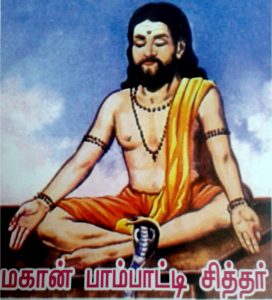
mahan-pambatti-siddhar – Marudamalai Temple
The Pambatti Siddhar Cave is another shrine drawing our attention. It is located on the slopes towards the East and can be approached by a narrow path, protected by a stone hedge or parapet. One can notice a natural image of a snake on the rock. There is an underground passage from the cave to the primal shrine through which the Pambati Siddhar wended his way everyday to worship Lord Subrahmanya in the Company of his consorts. Pambatti Siddhar used this cave as his abode for meditation on Bhagwan Muruga and attained moksha here. A snake comes to the cave everyday and feeds itself on the fruit and milk kept for it. Devotees offer milk and fruit for the snake.
PANCHA VRUKSHAM :
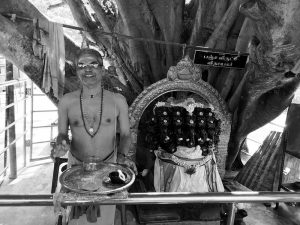
Pancha Viruksham Ganapathi – 5 headed Ganesha
There is a cluster of trees closely inter winding one another. Under this is installed an Idol of Lord Ganesha. Daily poojas are performed to this deity also. The breeze wafting along the foliage has an unfailing cure for all diseases of the people. A host of sages, invisible to the common man’s naked eyes, are supposed to dwell here doing meditation. An aged Irula tribesman, 80 years old identified the entangled trees as Korakattai, Ichi, Banyan, Vakkanai and Ottu maram (Maram means Tree in Tamil) and added there was one tree in the group, Peepal in the days of yore, and it is extinct now. The tribal man also said that this tree existed in the same manner even during his childhood. This is a unique phenomenon attracting not only devotees but also botanists.
Sattology about Sri PAMPATTI SIDHA :
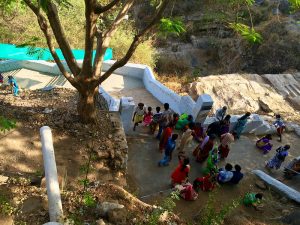
Approach to Siddar cave
The Pambatti Siddhar Cave is another shrine drawing our attention. It is located on the slopes towards the east and can be approached by a narrow path, protected by a stone hedge or parapet. Pambatti Siddhar used this cave as his abode for meditation on Lord Muruga and attained salvation here. One can notice a natural image of a snake on the rock. Siddhas are mystic philosophers who exercise their mental faculties to the utmost and attain godhead by means of meditation and reflection. They are endowed with incredible powers of the mind by which they perform great miracles and astound the common world. Siddhas can set at rest all their senses and awaken their spirit alone. Thus they are bodily asleep and spiritually awake. In this blessed mood they enter into a personal communion with God. It is believed that there were 18 Siddha’s. One of the 18 siddha’s used to animate dead snakes and dance with him, so he was popularly known as Pambatti Siddhar. Pambatti Siddhar greatly revered in the Kongu region, he is credited with having lived in the company of snakes and made them dance to his tunes. Once, in the course of his wanderings, he chanced to meet one, Sattai Muni Siddhar, a contemporary and counterpart who initiated him into the art of entering into trances – the Jeeva Samadhi Nilai. Once he transmigrated into the dead body of a king and performed great miracles. He composed songs of enlightenment. ‘Siddharudam‘ is a work, attributed to his prophetic genius. Bhagwan Muruga took joy in teasing and tantalizing the Siddha with his spiritual pranks. Once as an enormous boulder came down, rolling gaining momentum, the Siddha tried to halt it, arrested its movement and averted a great havoc.
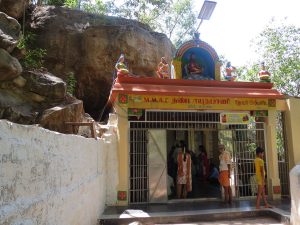
Pambatti_siddhar_sannidhi_ Marudamalai Temple
A snake comes to the cave everyday and feeds itself on the fruit and milk kept for it. There is an underground passage from the cave to the primal shrine through which the Pambati Siddhar wended his way everyday to worship Lord Subramanya in the Company of His consorts
Here is the sattology about how this place got the name Marudhamalai
The Sanskrit word “achalam” denotes mountain. As the mountain here abounded in marudham trees, it came to be known as Marudhachalam. Marudhamalai is also called Marundhumalai, (Marundhu means medicine in Tamil; Malai means hill or mountain in Tamil) for it is overgrown with shrubs and bushes of medicinal properties. Hence, Marudhamalai is befittingly given the name Marudhamalai (Mountain of Medicines). This is referred to as Marudhamalvarai, Marudhavarai, Marudha Verpu, Marudha Kundru, Marudhavōngal, Kamarpirangu, Marudhachalam, Velvarai in Perur Puranam.
Special Features of the Temple
The holy shrine of Marudhamalai is believed to remove both physical and mental afflictions and attachments as the hill abounds in Medicinal herbs. The pleasant breeze and the peaceful environments bring harmony and quietness to the minds of devotees. The sages and siddhars used to prefer this hill and came here in search of ‘KayaKalpam’ the Divine medicine for Moksha. The divine cow ‘Kamadhenu’ is believed to have grazed in the pastures of this hillock and drunk from the springs under the Marudham tree as per Perur Puranam written by Kachiappa Munivar.
Temple
Water Source
There are springs of holy water with the names Marudha Theertham and Skanda Theertham. A dip into these springs brings forth health and wealth to devotees.
Sthala Vriksham
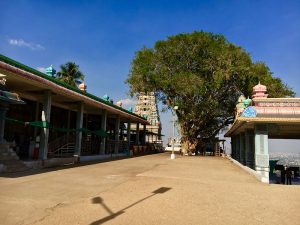
Sthal Vriksh – Marudamalai Temple
The Marudham tree (Terminalia arjuna in English) is the sthala vriksham (sacred tree of the shrine)
At length, we reach the top where God Subrahmanya reigns supreme in all His radiance, exuding all grace and charm! The idol made of granite is about five feet in height, facing the east with the right hand holding Dandayudham (rod), the left hand placed on the hip and a spear (vel) placed across. The image bears a close resemblance to the deity at Palani. The statue at the sanctum sanctorum, divested of all its adornments, loined with a slender cloth brings to our mind the ‘Andi Kolam’, the aspect of a mendicant assumed by the God in Palani. What distinguishes Marudhamalai Andavar from Palani Āndavar is the sporting of a turban on the head with a tuft behind. The beauty of the deity defies all description and is more a thing to be experienced than expressed!
Sage Kachiyappar says even tens of thousands of Maras (love gods) cannot match God Muruga of Marudhamalai in His magnificence! The word Marudhachalāpati means Master of the Hills that abound in Marudham trees. The Lord assumed the appellation after the association of the words, Marudham, Achalam and Pati, representing the Marudham tree, the hills and the Master respectively.
Sattology – How 3 thieves got petrified
Standing at the foot hill, as we gaze towards the North, in the distant hills, we discern three stones in diverse colors, which are the petrified form of three thieves cursed by God Muruga for their sinful act of plundering the treasures belonging to the Temple. Just below the stone forms, there is a flat stone which, it is said, is but the jewel box stolen by the thieves. God Muruga came in the guise of cavalier, chased and punished them.
How to reach Marudamalai Temple – Location from Google maps – Click Here.
Pics Credit: Flickr and Google
- Approach to Siddar cave
- In front of main deity – Marudamalai Temple
- Entrance to Temple
- Entrance to Temple
- Dwaja Stambam
- View of Coimbatore City
- God Murugan in Golden Chariot
- Gopuram
- View from the Temple Gopuram
- Approach to Siddhar Cave
- Ganesha carved on Stone
- View of the Temple
- Dwaja Stambam
- In front of Main Deity
- Pambatti Siddar Shrine
- Panorama view – Marudamalai Temple
- Sthal Vriksh – Marudamalai Temple
- Approach to Siddar cave1
A small video on aerial view of Marudhamalai Hills and Temple respectively. Video Credit – Click here
All information entered is personal to the author. Any modification or changes must be addressed to the author.

